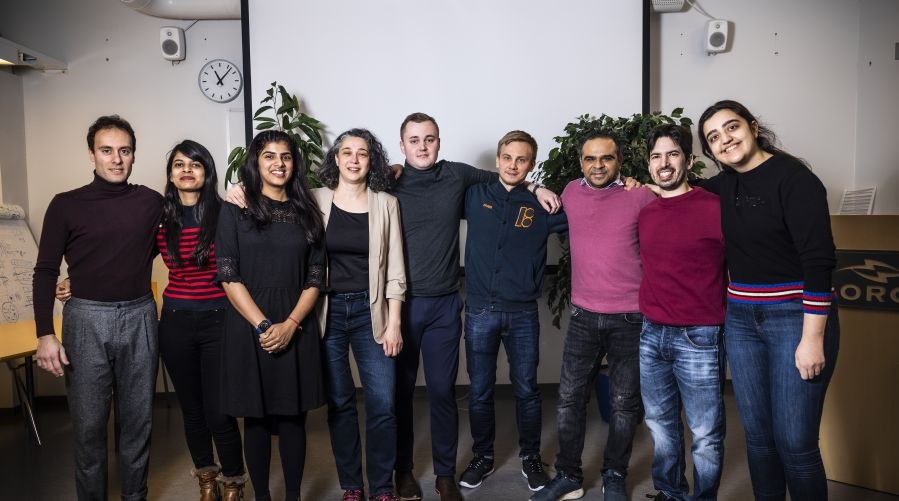Professor Humeyra Caglayan receives an ERC Proof of Concept grant to study all-optical timekeeping

Since childhood, Professor Humeyra Caglayan has been interested in how things work in nature. As a scientist, she has a strong ambition to develop meta optics based on metamaterials and light.
“I love every aspect of physics but have been amazed by light. Over the years, I pursued being a physicist to understand how things work and how we can explain them, especially light-based phenomena,” Caglayan says.
The core of her work is designing, optimising, fabricating, and testing metamaterials for meta-devices that can be used for imaging or communication purposes. The idea is to make these devices more efficient, functional, and less energy-consuming.
Better timekeeping with metamaterials
In the project TIMEKEEPER – All-optical time-interpolation with Epsilon-Near-Zero Metamaterials, Caglayan will research metasurface-enhanced materials for all-optical timekeeping. In the background is the fact that the ability to synchronise multiple events with ever-improving precision has allowed humans to accomplish increasingly complex tasks.
“An orchestra conductor, for instance, enables synchronisation and the control of dozens of musicians with tens of milliseconds of precision, optimising one of the most universally acclaimed art forms. However, in current technology, we need to achieve the higher time precision at the femtosecond (fs) scale and even attosecond (as) along with minimised drift over time,” Caglayan explains.
This project will apply novel metasurface-enhanced materials for timekeeping. The research team will develop an optical time measurement setup to work with the optimised power and spectrum conditions and make the whole system work as a compact device.
“Together with my team, we will develop the meta-device and do the market analysis and value creation. We will work with the commercialisation team to realize potential and transform towards a commercialisable IP or a product,” she adds.

Recently, Caglayan’s research group Metaplasmonics has also been developing meta optics for imaging applications. One of their goals is to develop efficient and very thin lenses, for example, for the cameras in mobile devices.
Another one of their projects is also based on metamaterials but focuses on quantum optics. The aim is to develop an environment that can be useful for quantum communication even at room temperature where currently cooling is required.
Driven by a thirst for knowledge
In November 2022, Humeyra Caglayan was nominated as the second female professor of physics at Tampere University.
“I hope this professorship will give me more flexibility to learn in areas I don’t have much experience. This way, I can include new knowledge in our projects and contribute to new research areas with our current know-how,” Caglayan says.
One example is developing meta-optics for biomedical microscopy. This new microscopy can provide high-quality volumetric images in a single shot without exposing the specimen to light for too long.
A career in metamaterials and photonics
Humeyra Caglayan received her doctoral degree in applied physics in 2010 at Bilkent University in Ankara, Turkey. After that, she moved to the United States with her family, where she completed her postdoctoral studies at the University of Pennsylvania (UPENN). Since then, she has been working on metamaterials and plasmonic devices.
Caglayan joined Tampere University of Technology in 2017 to work as an Assistant Professor in the photonics department. After the two universities in Tampere merged, she moved one step ahead in her career and was promoted to Associate Professor in the physics department specialising in photonics in the photonics unit.
ERC Proof of Concept grant for refining the technology
The TIMEKEEPER project is funded for 18 months by the European Research Council (ERC) which awards grants to outstanding scientists who pursue frontier research. ERC Proof of Concept grant is only open to current or recent ERC grant holders to explore the commercial or societal potential of their ERC-funded research. The funding is part of the EU's research and innovation programme, Horizon Europe.
Overall, ERC funding has now been awarded to 15 researchers at Tampere University since 2015.
In 2018, Humeyra Caglayan received an ERC Starting Grant for her project aQUARiUM (QUAntum nanophotonics in Rolled-Up Metamaterials). That project will run until the end of 2023.
Read more about Humeyra Caglayan’s research work on the Flagship on Photonics Research and Innovation (PREIN) website. PREIN is a light-based technologies competence cluster for multi-disciplinary science, industry, and society, funded by the Academy of Finland.
Further information
Humeyra Caglayan
+358 50 447 8330
humeyra.caglayan [at] tuni.fi (humeyra[dot]caglayan[at]tuni[dot]fi)






